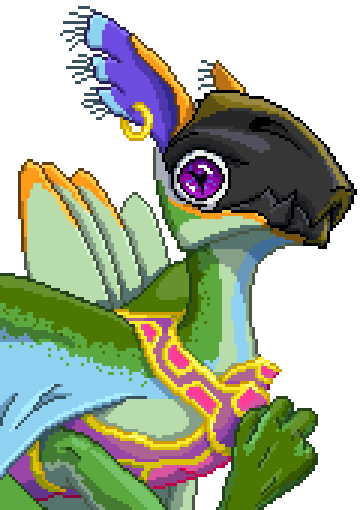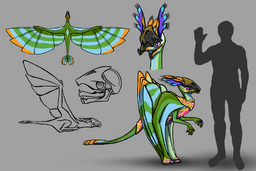Cliffworld:Ktak
Ktak are small flying creatures. They’re naturally better adopted to the environment of the Wall, and so consider it be their righteous home, and regard humans as visitors at best, though Ktak themselves, just as humans, do not originate from this world.
Ktak are less numerous than humans though, and can’t haul may supplies by themselves, so their dominion over the Wall is not absolute. Humans respectively refer to ktak as “Dragons” sometimes, since while not numerous enough to drive humans off the wall and being deceptively small, ktak offensive capabilities and army speeds greatly excel those of somewhat unwieldy human airships, so any state foolish enough to anger them will soon be torn apart by fast and precise unpredictable attacks.
Persistent Empire
The single expansive Ktak polity, encompassing most of the known Wall ktak populations.
Culture
Ktak are repulsed by open displays of food consumption, and the only proper way of eating for them is in reclusion, away from other’s eyes. Reproduction and sexuality in general plays an important role in the species culture, but in a way that’s entirely different from what might be expected. The actual sex drive of Ktak is very low and generally reaches peak only during a half-a-year mating season. Nudity isn’t considered a taboo, but any sort of intimate and sexual activities are heavily and excruciatingly intricately ritualized, and following all of these rituals down to the smallest detail is considered a paramount for civility. The species relationship with sex permeates its entire culture and way of thinking, I.E. a ktak would say “I was impregnated with knowledge” instead of “I learned something”. Some people become interested in Ktak culture due to this detail, but generally their enthusiasm dies out extremely quickly as soon as they get their first experiences interacting with Ktak culture, which turns out to be suffocatingly restrictive and regulated in many aspects. Ktak generally disregard humans and view them more like an unfortunate reality of the world than equals. Ktak are capable of recognizing and being impressed by the efforts and skills of humanity, particularly in ways how they overcome the hurdles of being flightless species in a world like The Wall, but they still hold them as inconsequential. Though with the start of the industrial revolution and invention of large airships, the power dynamic between the two species began to change and level out.
History
TBD. Ktak have appeared on The Wall much earlier than humans, but they too do not know their true origins nor the beginning of their history on the Wall.
Government
Matriarchal theocracy. Ktak are highly religious, so many females are simultaneously holding positions of power and viewed as divine.
Religion
Monotheistic worship of Creator of All That Is.
Military
Most Ktak military consists out of lightly armored soldiers performing airborne attacks on the enemies. The lethality of their war methods were only exaggerated further with the invention of firearms that allowed Ktak to carry relatively lightweight ranged weaponry and it basically revolutionized their war doctrine.
Language
Generally they talk in their language that somewhat resembles something inbetween crow cawking and general bird chirping, but many of those that have to deal with humans are nearly fluent in English.
Biology
Ktak are stacked extremely lightly in order to be able to fly, most individuals weigh no more than 35 kg. Their skeleton consists of hollow bones, like birds. Their body is covered with small, short hairs, which in general constitute a smooth, silky cover, reducing air friction well. Ktak has quite sensitive ears, at the ends of which, in addition to everything else, are sensitive vibrissae that can catch the fine movement of air currents.
Technology
In regarding of industrial development Ktak by now are trailing behind the human world, with their main obstacles being undeveloped infrastructure and logistic that’s unsuited for transportation of large amounts of heavy cargo. More and more ktak end up hiring humans to build railvators and operate cargo airships to transfer goods, bringing the species closer together.
Economy
TBD
Power generation
Traditionally most of the ktak technology operates via either solar heating or wind. Introduction of human steam engines began to swiftly outcompete these unreliable methods.
Science
Science is considered a significant portion of Ktak religion, and as such is heavily theocraticized. It causes ktak to spearhead research in areas that would align with the religious beliefs while leaving other venues barely any attention at all. Most of the population is not educated beyond what’s necessary, with the exception of clergy.
Food
TBD
Entertainment
TBD. Mostly songs?
| Leaving the Cradle | The Cliff World | |
|---|---|
| Places | The Wall |
| World | Skystone |
| Technologies | | |
| Culture and societies | Persistent Empire |

